Introduction
The digital landscape is in a constant state of evolution. Since Inlight's inception in 2008, the purpose and function of the web, mobile apps and other digital assets has shifted dramatically.
The job for digital managers and service providers has never been more complex, making it an important time to look back and reflect on where we have come from (both individually and collectively), unpack the challenges and obstacles faced in recent times, and take the opportunity to explore what the future of digital might look like.
The objective of this document serves a dual purpose:
- —As Inlight marks its 15th anniversary, it is an opportune moment to consolidate our learnings into a tangible resource for future endeavours.In a services-based industry, finding the time for introspection is never easy, and our commitment first and foremost will always be to our team and clients. But now, as much as ever, it's crucial that we take stock of where we have come from so that we might understand where we are heading.
- —It exists to articulate a guiding philosophy for constructing digital products that maximises the chance of long-term success for our clients and partners.The digital landscape is ever expanding and non-linear, resulting in countless ways to approach the same problems. While there is no universal solution, our experience over the past 15 years has led us to a recurring theme: the utility of 'composable thinking.'
This written piece aims to explore the present-day challenges facing digital leaders and to demonstrate how composable thinking can offer more effective and sustainable solutions. To substantiate these concepts, the document will include real-world examples, articles, and case studies.
Part 1
How did we get here?


The trajectory of the World Wide Web over the last 30 years has been nothing short of transformative.
Originating as Web 1.0—a static information hub—the internet has undergone continual metamorphosis, evolving into today's multifaceted digital landscape. What began as a rudimentary platform for data dissemination has grown into an intricate, functional medium that enriches our personal and professional lives in countless ways.
Consider, for instance, the leap from Web 1.0 to Web 2.0 around 2004. The latter ushered in an era of collaboration and user-generated content. This shift wasn't merely incremental; it represented a seismic change in how users interact with the digital ecosystem. From the advent of social media to the proliferation of mobile, e-commerce and cloud computing, the web has expanded its utility exponentially. Businesses, once content with online 'brochureware,' now rely heavily on a broad array of digital tools to remain competitive in a global market.
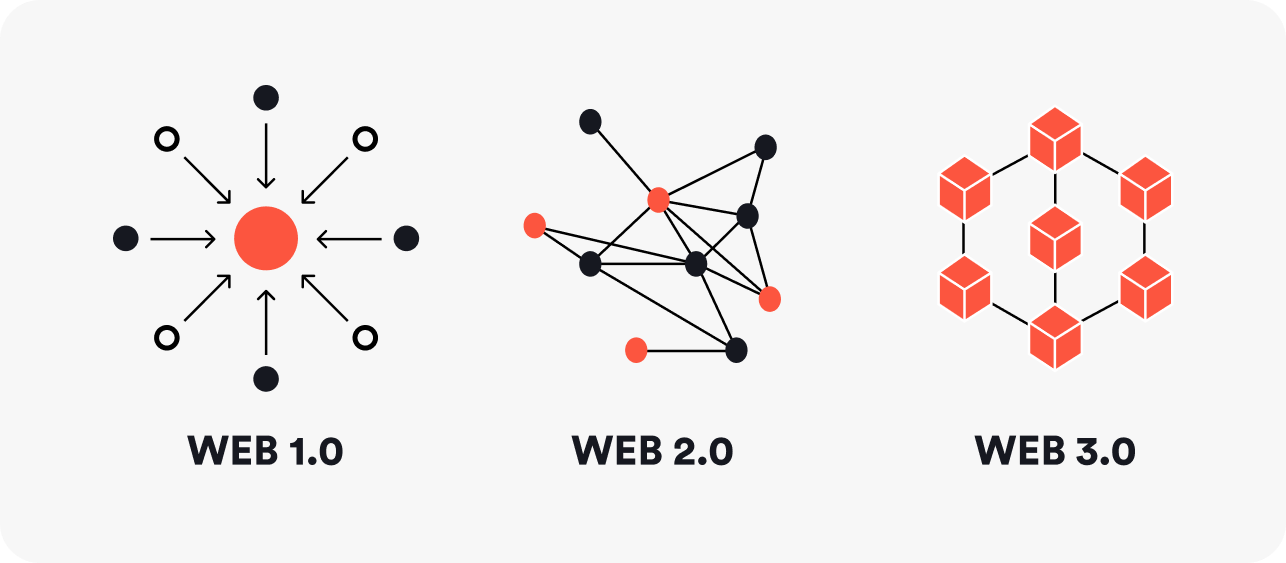
Why is this crucial to understand?
The internet and digital ecosystem have become increasingly more complex. As we advance towards Web 3.0—a semantic, intelligent web—some of the tools and processes we once leaned on to streamline our digital endeavours have become bloated and obsolete, limiting the pace and potential of what can be achieved. This mounting complexity demands a rethinking, steering us towards breaking digital products into more manageable, efficient components.
As the utility and function of the web exploded over the last two decades, we witnessed the surge of platforms adept at consolidating diverse needs into singular 'monolith' solutions. This encompassed tools like Content Management Systems (CMS), E-commerce platforms, Customer Relationship Management (CRM) systems, and even Enterprise Resource Planning (ERP) solutions. The monolithic architecture wasn't merely a platform preference but also a dominant design pattern for building complex digital products.
This approach of aggregating various functions into one unified system had distinct advantages at the time:
 Ease of development and deployment
Ease of development and deployment Speed and efficiency within small teams
Speed and efficiency within small teams Easier to test and debug
Easier to test and debug Easier to maintain
Easier to maintain
Though monolithic systems initially provided many benefits, they soon showed significant limitations as their scale increased. Features that originally streamlined operations turned into sources of inefficiency and rigidity. Multi-faceted products became expensive and hard to use and often failed to deliver their promised value.
As time went on and systems continued to evolve, more and more problems arose with these types of systems, including:
 Difficulties and cost in scaling
Difficulties and cost in scaling Innovation and progress were slowed
Innovation and progress were slowed Minor changes had wide-reaching implications that slowed development and evolution cycles
Minor changes had wide-reaching implications that slowed development and evolution cycles Tight coupling of functionality meant a failure in one component often led to entire system failures
Tight coupling of functionality meant a failure in one component often led to entire system failures Platform lock-in, which led to high-risk dependencies and loss of organisational autonomy
Platform lock-in, which led to high-risk dependencies and loss of organisational autonomy

One poignant analogy is that of a large ship; the bigger it gets, the harder it is to change course.
This holds true for both digital systems and organisational structures. Operational complexity grows, and increasingly, more resources are funnelled into mere sustenance rather than value creation.
In light of these challenges, the concept of 'Digital Transformation' gained traction in the enterprise space. Broadly defined, Digital Transformation is the process by which companies employ a new or upgraded technology across their business to drive fundamental change. Due to the size and complexity of these technologies, these initiatives often turned into sprawling, multi-year projects that seldom delivered on their promises. A 2021 report by Boston Consulting Group substantiates this point: only 33% of Australian companies succeed in their digital transformations, while 47% create some value, and a concerning 20% generate limited value. These figures underscore the daunting complexities and pitfalls associated with large-scale transformation projects.
Among the challenges:
- —Shifting team compositionsThe long timelines often meant changing team members, leading to a loss of accumulated knowledge.
- —Rapid technological changesWhat was cutting-edge at the project's inception often became obsolete or sub-standard by its conclusion.
- —Resource allocationThe focus on transformation often left existing systems in a state of neglect, introducing risks to customer satisfaction and platform security.
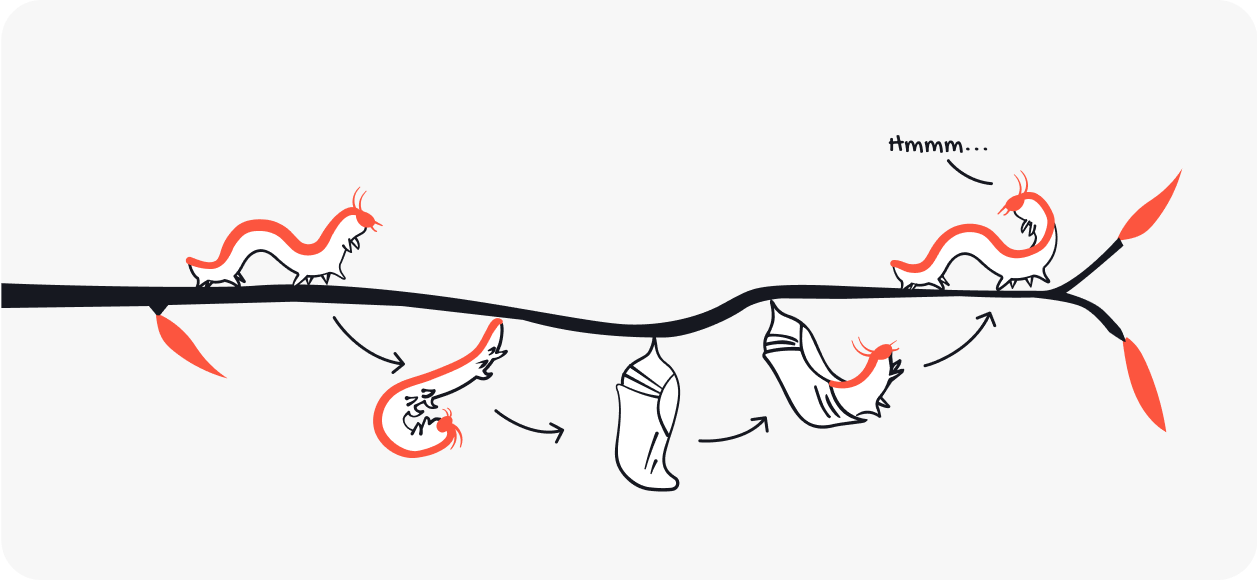
Many years ago, Inlight gave a presentation entitled 'Where are all the butterflies?' which discussed the challenges digital transformations face when companies enter a cocoon for several years, hoping to emerge as a beautiful butterfly. Sadly, what often happens is that their customers are neglected for many years, and the caterpillar never transforms into the butterfly that was promised.
So, what's a solution to these compounding complexities? The principle is surprisingly simple: decomposition. Whether we're talking about teams, platforms, products, or strategies, breaking systems into modular, autonomous components can yield greater agility, speed, and specialisation. This paradigm is known as 'composability,' and its application extends beyond product development to every facet of our work.
Part 2
Composability as a Philosophy


Anyone who has worked in the digital industry over the past decade has likely heard the term 'composable architecture'. The simplest way to describe this term is the idea of building software from small, independent components that can be combined to form a complete system. Typically, these components are connected via a common interface language or API (Application Programming Interface) and can be seamlessly integrated to build more complex solutions.

A physical analogy that relates perfectly to this idea is LEGO. Whilst each LEGO brick provides a unique form or function, the universal connection pattern allows a collection of components to be built into complex machines or structures. Whilst this pattern is well known in the software industry, the principle can be applied to any complex system. Below, I'll explore how this philosophy can be leveraged across various parts of your business and their digital products. In each case, I'll look at some of the benefits and considerations. However broadly speaking, composability can be viewed as insurance against change. It provides a way of building agility and resilience into the foundation of any system.
Composability can be viewed as insurance against change. It provides a way of building agility and resilience into the foundation of any system.
 Google Trend: numbers represent worldwide relative search interest for "composable architecture" over 5 years
Google Trend: numbers represent worldwide relative search interest for "composable architecture" over 5 yearsComposability in Development


Introducing MACH
When planning your next digital product, understanding certain development patterns aligned with composability is key. One such pattern is the MACH architecture, popularised by the MACH Alliance.
The MACH Alliance is a not-for-profit advocacy group whose members include software vendors, systems integrators, agencies, and individual experts, called "Ambassadors", advocating for open and best-of-breed enterprise technology ecosystems
MACH stands for four core principles in product development: Microservices, API-first, Cloud-native, and Headless. These principles steer from traditional monolithic design towards a more modular and composable approach.
 MicroservicesDistinct units of business functionality that are developed, deployed, and managed independently.
MicroservicesDistinct units of business functionality that are developed, deployed, and managed independently. API-first All functionality is available through APIs.
API-first All functionality is available through APIs. Cloud-native Software that utilises the cloud for more than just storage; for example, elastic scaling and automatic updates.
Cloud-native Software that utilises the cloud for more than just storage; for example, elastic scaling and automatic updates. Headless The presentation layer is decoupled from backend logic, providing flexibility in how your content is delivered.
Headless The presentation layer is decoupled from backend logic, providing flexibility in how your content is delivered.
Whilst these principles do not mandate an 'all-in' approach, used together they provide the best chance of long-term success for your solution.
Benefits of implementing a MACH-based architecture:
- —Customer-centricSeparation of presentation layer from backend systems and business logic allows you to create the best possible user experience for customers without the limitations of core systems.
- —Best-in-breed technologyRather than being locked into a single monolith or specific ecosystem, MACH allows you to pick and choose a collection of best-in-breed technologies that fit each specific need.
- —ExtensibilityEasily add new features, functionality or integrated solutions over time and support full omnichannel delivery on any device or platform.
- —Scalability and performanceReplace slow monolith solutions with infinitely scalable, high-performance cloud-based services.
- —Enhanced stability and securityDecoupling services ensure a single failed or compromised component is localised and does not impact your entire system.
- —CostVarious short-term and long-term cost savings can be achieved through reduced licence costs, efficient cloud hosting, reduced upgrade costs and shorter time to market.
- —Fast, flexible developmentAllow developers to work with the tools and technologies they prefer at each layer of the stack. Decoupled presentation layer and modular services allow for efficient development of isolated components and remove dependencies and bottlenecks.
- —EvergreenCloud-native encourages all updates and releases to be automatic and immediate and not dependent on an individual implementation or deployment cycle.
- —Future proofIntrinsically compatible with future growth and scalability through the freedom to swap out and improve components over time.
To put MACH architecture into a relatable context, consider the rise of headless Content Management Systems (CMS). Traditional CMSs tightly couple the content and business logic layer (back-end), which limits the ability to serve the same content to multiple digital products or assets. It also makes integrating content or functionality from other sources outside the chosen CMS challenging. A shift to MACH means the CMS is headless (no inherent presentation layer), content is served to the front-end via an API, the CMS itself is often cloud native and/or fully managed, and additional microservices can be used to provide specific functions to the website or app.
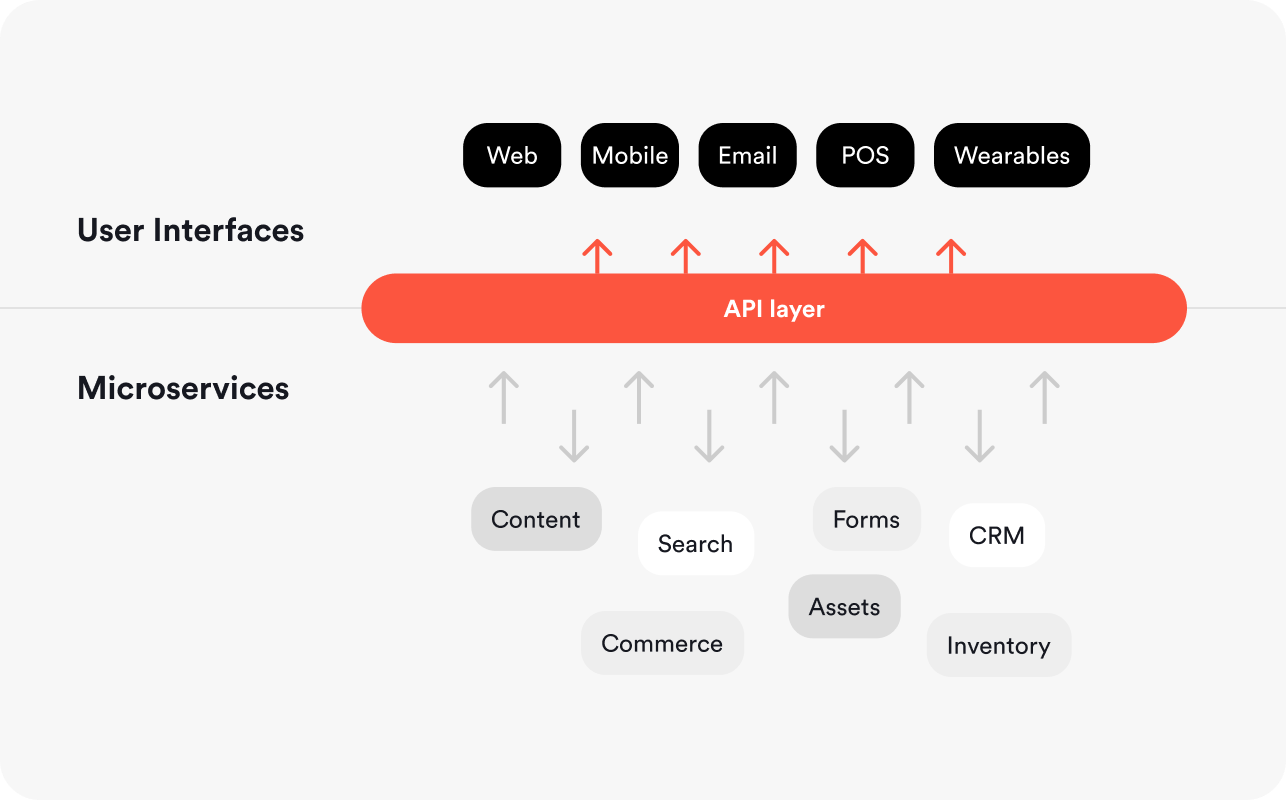 MACH Architecture
MACH ArchitectureTo illustrate the practical advantages of adopting MACH principles, particularly a headless CMS, let's look at some real-world applications. Industry leaders like Adidas, Airbnb, and the New York Times have migrated to headless CMS architecture. Similarly, closer to home, JB HiFi, Atlassian, Kmart, Officeworks, and Scentre Group (Westfield), along with our own clients Powershop, Nando's, Vicinity Centres, and Transport Accident Commission (TAC), have all reaped the rewards, reporting marked improvements in site performance, content delivery, and operational flexibility.
Global software pioneer Atlassian utilises a headless CMS to centralise content for a myriad of external support services: everything from help articles and technical documentation to in-product support and resources for prospective customers. The impact on speed to market has been transformative. Before migrating to a headless CMS, it took Atlassian two weeks to publish content; now, that timeframe has been slashed to just 5 minutes.
- —Case study: AtlassianHow Atlassian scaled its external support capabilities with Contentful
What are some of the leading Headless CMS platforms?
If this approach sounds appealing, you might wonder which headless CMS platforms you should consider. Here are some that we use regularly with great effect when building products for our clients.

Each platform has its strengths and weaknesses, and the best choice will ultimately depend on your organisation's unique requirements. Therefore, conducting a thorough evaluation is crucial to determine the best fit for your business's needs and workflows.
Introducing JAMstack
Another architecture pattern you'll encounter in the composable architecture landscape is JAMstack. Unlike MACH, which is a comprehensive strategy for both the front-end and back-end, JAMstack is predominantly focused on the front-end or client-side/user interface. The term is an acronym for JavaScript, APIs, and Markup. It employs pre-rendered static pages served through a Content Delivery Network (CDN), with JavaScript handling the dynamic aspects via APIs.
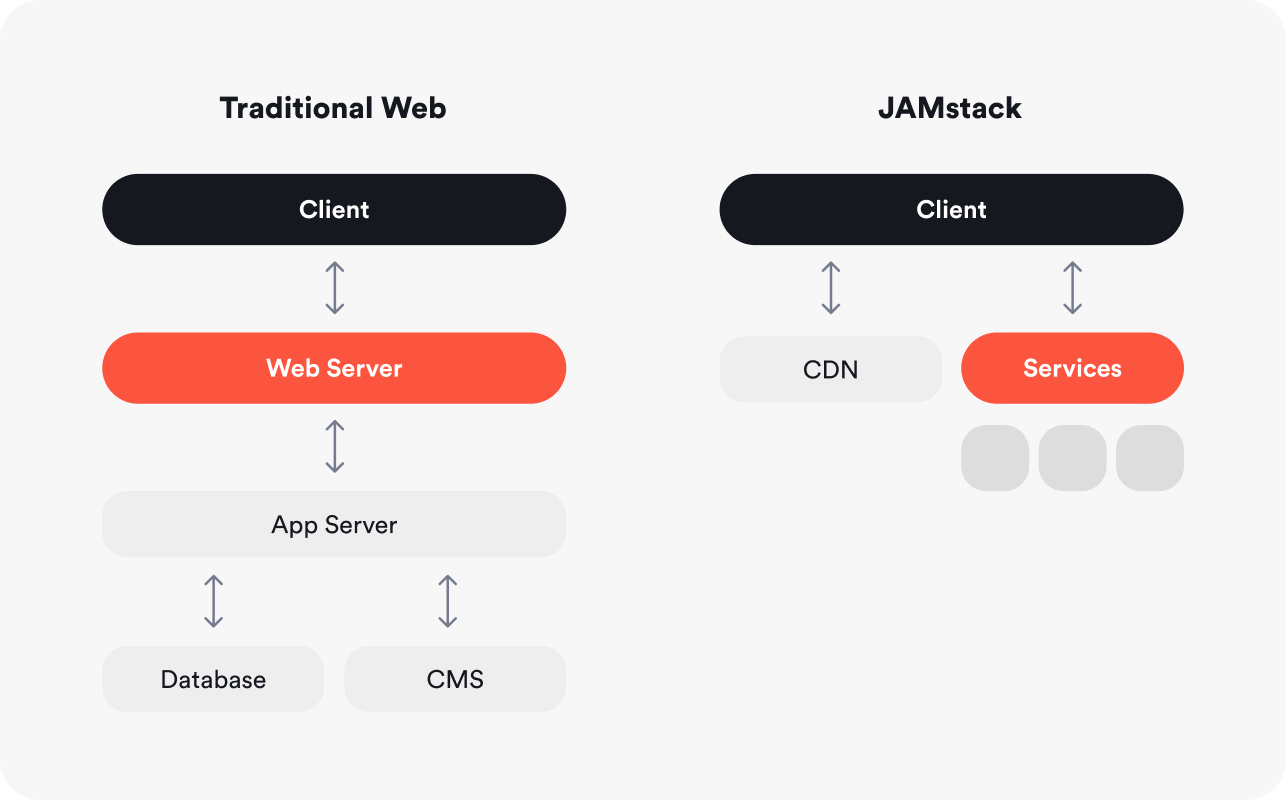
The benefits of JAMstack overlap significantly with those of MACH:
- —SecurityWith a simplified hosting infrastructure and pre-rendered, read-only pages, JAMstack provides robust security measures against attacks.
- —ScaleCaching and CDN support make it exceptionally good at managing high traffic and avoiding back-end bottlenecks.
- —PerformanceLight-weight API requests and client-side processing mean quicker page load times, which could significantly impact user experience, conversion rates, and SEO rankings.
- —MaintainabilityCDN's reliability and the static nature of the pages result in minimal maintenance.
- —PortabilityJAMstack's architecture is remarkably versatile, making it easy to migrate or upgrade with little hassle.
- —Developer ExperienceJamstack allows for a wide variety of tools and techniques that do not lock developers into proprietary technologies or frameworks.
Another important but more intangible benefit is the ease of attracting and retaining top-tier developers. As the demand for software engineers grows, aligning your architecture with sought-after technologies can be a strategic move for long-term success.

Mini Case Study: ANZ Banking Group
A local success story extolling the benefits of composable architecture is the ANZ Banking Group. ANZ has embarked on an evolutionary journey, rearchitecting its "monolithic" applications to be composed of microservices and API-based services. The shift has already led to improved stability, reliability, and speed of new feature delivery.
"Previously, it was only a certain number of teams and engineers that could work on a particular monolith application. Now that we've moved to a microservices architecture, we've got the ability to have multiple squads working on multiple services in parallel. We're really seeing a big uptake in our feature delivery by moving to this new architecture."Peter Tsatsaronis, Product area lead for digital channels in institutional technology, ANZ
Key Takeaways from ANZ's shift:
- —Improved Stability and AvailabilityBefore, when a part of their monolithic system went down, it took the entire application. Now, issues can be isolated to specific components, ensuring that most functionalities remain operational for users.
- —Increased Cadence in Feature DeliveryThe shift allows multiple teams to work on multiple services in parallel, leading to quicker deployments of new features.
- —Scalability and Learning from User BehaviourWith real-time data coming in, ANZ is continually refining how services are broken down to optimise performance and customer experience.
- —Scalability and Learning from User BehaviourANZ foresees additional advantages once more microservices are migrated to cloud-based platforms.
This case study not only validates the efficacy of adopting composable architecture but also highlights the considerations needed when breaking down a monolith. One of the key challenges faced was how small to make each service. Break it down too much, and you're looking at a maintenance nightmare. But if you don't go far enough, you might miss out on some of the advantages of composability.
- —Article: iT NewsANZ continues to re-architect its "monolith" applications.
Composable UI
The principle of composability also extends to the user interface, revolutionised in part by Facebook's front-end JavaScript library, React.JS. React enables the construction of UIs from reusable components. This modular approach ensures a more cohesive user experience, accelerates development, and improves performance. In addition to React.JS for web apps, its sibling, React Native, offers similar benefits for mobile app development. Popular alternatives such as Angular, Vue.js, and Ember.js offer similar frameworks depending on your team's preferences and experience.
Front-end frameworks that support a composable UI:
| Framework | Description |
|---|---|
| React.JS | A JavaScript library for building user interfaces, particularly known for its component-based architecture and virtual Document Object Model (DOM). Often used for web applications. |
| React Native | An extension of React that allows you to build native mobile applications for iOS and Android using JavaScript and React. |
| Angular | A TypeScript-based open-source framework for building web applications developed by Google. Features a rich set of tools and a powerful ecosystem. |
| Vue.js | A progressive JavaScript framework for building user interfaces. It is incrementally adoptable and designed to be simple yet powerful. |
| Ember.JS | An opinionated JavaScript framework for building ambitious web applications. Provides a set of conventions and best practices out of the box. |
In addition to these frameworks, newer tools such as Tailwind UI are making user interface (UI) development even more efficient and composable by provisioning ready-made, expertly designed components provided in React and Vue and powered by Headless UI.
Considerations for composable development
Like any other technology or approach, the above methodologies and frameworks are not the answer to every problem.
There are several considerations or costs for choosing these paths, and there are things to be aware of before embarking on a composable re-design:
- —Change managementMoving to a composable architecture requires a significant shift in mindset in how to develop, maintain and engage with your digital assets. It can take time to upskill your development team and other stakeholders that interact with these digital assets.
- —ComplexityWhile composability can significantly reduce complexity in individual systems and functions, it can lead to a more complex digital ecosystem overall. Choosing and integrating best-in-class technologies that meet your specific needs also means understanding, maintaining and evolving more systems and technologies across your entire digital portfolio.
- —SetupIndividual monolith platforms often provide out-of-the-box, ready-to-use capability that requires minimal setup or configuration. Implementing a custom set of integrated solutions can sometimes increase the initial effort required to get things up and running.
- —Teaming and CapabilityImplementing a composable architecture may mean understanding a more diverse set of development languages and solutions. This may require a shift in internal teaming to ensure there are enough skilled team members to support these individual components, which may prove prohibitive for smaller organisations with limited resources
Future Considerations: Adaptability through Composability
While the shift towards a composable architecture is significant on its own, it becomes crucial when you consider the ever-evolving technology landscape.
- —Web 3.0Composability is core to the principles of Web 3.0, a user-centric, decentralised internet. Open standards and interoperability are key, allowing organisations to easily integrate emerging technologies like blockchain.
- —AIGenerative AI and large language models are breaking new ground in AI. A composable approach allows easy integration of these tools, enabling organisations to keep pace with AI advancements without major overhauls.
- —Internet of Things (IoT)The sheer scale of IoT demands a composable architecture. It's not just about connecting devices but doing so in a way that's efficient and scalable, enabled through robust APIs and event-based architecture.
- —Extended RealityAs AR (Augmented Reality), VR (Virtual Reality), and MR (Mixed Reality) technologies mature, a composable architecture can adapt readily, allowing organisations to more easily experiment with new platforms and delivery mechanisms.
By adopting a composable architecture, organisations don't just prepare for the current digital landscape but create a resilient, adaptable foundation for whatever the future holds.
Composability in Design


In the realm of software development, the term 'composability' often conjures images of modular code, microservices, and APIs. However, composability isn't a concept restricted to developers; it also plays a pivotal role in design.
While development focuses on building systems from reusable, interchangeable components, design aims to create user experiences that are intuitive, adaptable, and scalable.
When both design and development embrace a composable approach, the result is a harmonious blend of form and function. The synergy between the two ensures that not only is the system's architecture robust and flexible, but its user interfaces are also fluid and user-centric. This section explore how applying composability principles to design can elevate the entire lifecycle of your digital products.
Modular Design Systems
The idea behind modular design systems is akin to using building blocks. Let's re-use the LEGO analogy here to explain. Imagine your design elements as LEGO pieces—each one distinct yet designed to fit seamlessly with the others. This approach enables you to construct complex layouts and pages from a set of simple, reusable components. The real value here is efficiency and consistency. When a change is made to one "block," it cascades across all instances where it's used, ensuring a consistent user experience and accelerating design iterations.
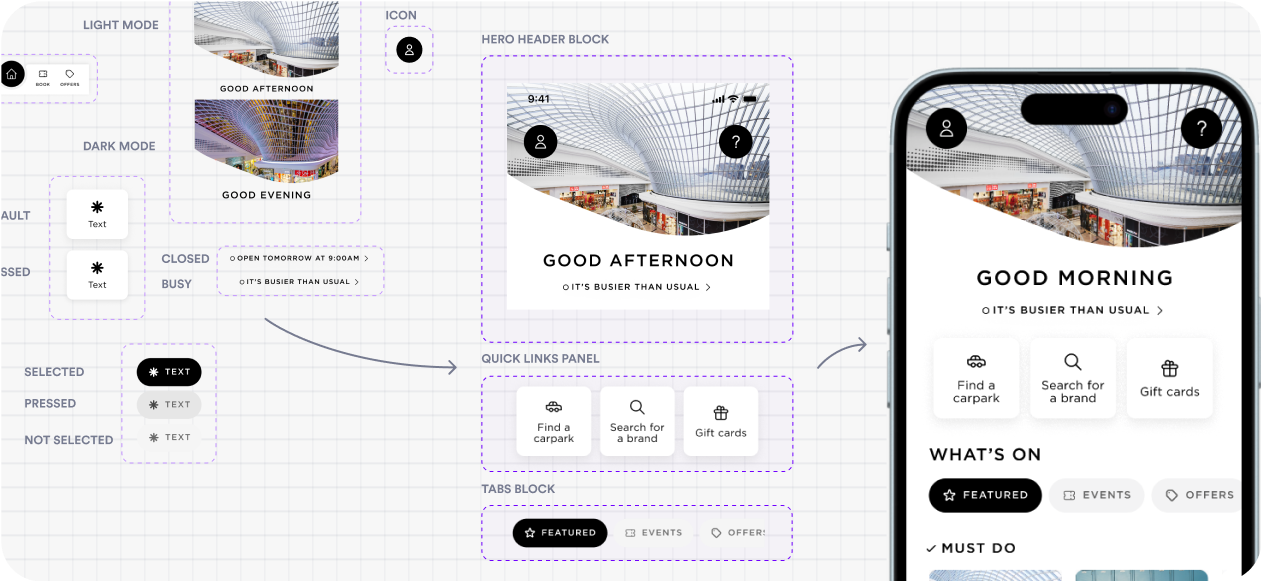
By using a modular, component-based design system, you can easily scale your digital products. Need to add a new feature or redesign a specific user journey? Simply rearrange, add, or remove the necessary components without affecting the entire ecosystem. This modular approach allows for easier, more cost-effective iterations. It also allows larger design teams to work from a consistent, centralised design system whilst focussing on their specific area of responsibility or functionality. Online design tools like Figma make this collaboration even easier, with real-time synching of changes that mean updates to a component flow through immediately to other parts of the design system.
Atomic Design Principles and Tokens
Atomic design is about breaking the building blocks into their most basic forms and working up from there. You start with fundamental elements like type, colours, buttons and icons, which combine to form molecules (cards, lists, etc), organisms (headers, footers, forms, etc), and ultimately whole templates and pages. This granular focus ensures you have all the building blocks you need to construct any interface.
Aligned with Atomic design, design 'tokens' act like variables in programming. Rather than specifying a button should be a particular blue "#0024FF" for example, you'd set it to "Primary Colour". If that primary colour changes, it can be updated in one place, and the change cascades throughout the design system. This simple yet powerful concept ensures that design elements can adapt quickly to different themes or branding changes.
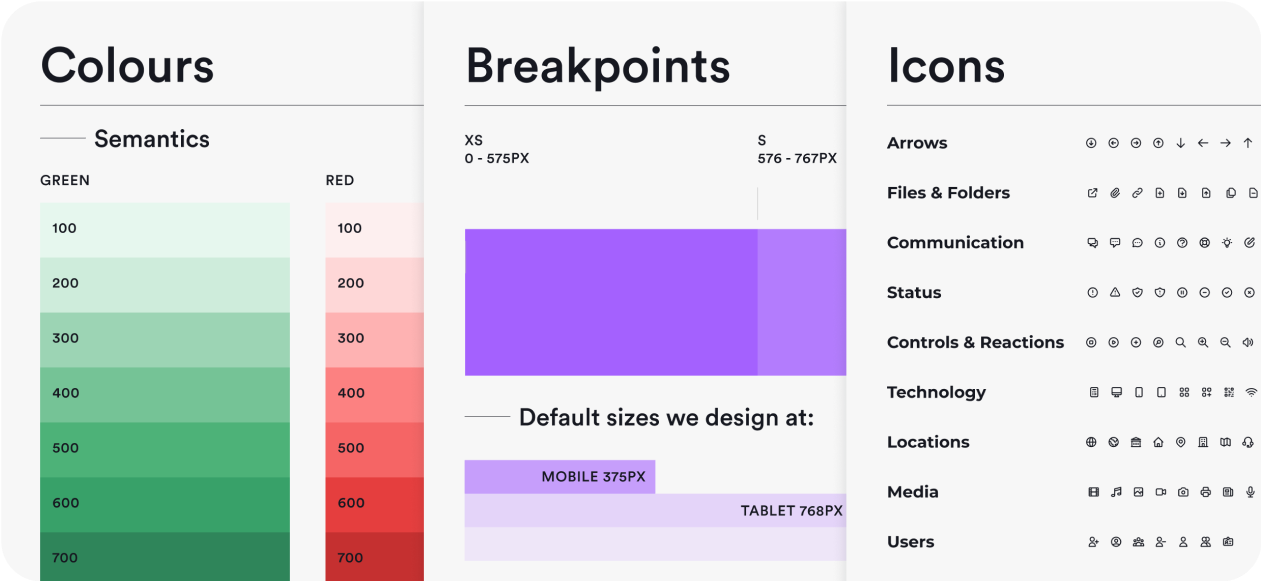 Figma atomic design set up
Figma atomic design set upA composable design philosophy dovetails beautifully with our commitment to a user-centric approach to product development. The flexibility of component swapping enables the ability to adapt swiftly to user feedback, conduct effective A/B testing, and continually optimise the user experience over time.
Collaboration is Key
While composability in design focuses on how design elements work together, its full potential is unlocked when there's a seamless collaboration between designers, developers, and other stakeholders. When considering the "design-to-development" handoff, it's not merely about passing a static design file to a developer. It's an ongoing conversation, facilitated by tools like Figma and Storybook, that ensures the design's integrity is maintained during the development phase. Maintaining a close link between design and UI components also ensures consistency in how components can be organised and utilised within a design concept and end solution.
Future-Proofing Through Composability
As with development, the modular nature of composable design is a built-in insurance policy for the future. When your design components are modular, updates become a breeze. If a design pattern needs to change—be it due to user feedback, in market performance, updated branding guidelines, or accessibility standards—you only need to update it in one place.
Future-proofing is not just about looking forward but also leveraging what you've built before. A composable design enables you to reuse components across different projects, departments, or companies. This saves time and resources and ensures a consistent user experience across various touchpoints.
Composability in Strategy


One of the consistent things we hear from our clients and organisations is that they have a well-established long-term technology strategy but a lot of uncertainty on how to practically execute that strategy and start making progress towards their long-term goals.
These strategies often involve a series of interrelated dependencies and significant investments that present a lot of risk and uncertainty. Combined, these factors encourage slow decision-making and hesitancy to invest in change, which is counter to competitive progress in a fast-moving environment.
There are three key ideas that we advocate when looking at and supporting an organisation's digital strategy. They all align with composable thinking and encourage agility and evolution over rigidity and perfection:
Evolution Over Transformation
The term 'digital transformation' often evokes a significant degree of hesitation and consideration within our team. Whilst the process of transformation is often necessary and can be effective, the approach and expectations of these transformations are often misaligned with reality and the level of uncertainty in which the transformation is taking place. Transformations often fail to deliver on their promise and required investment for various reasons:
- —Goals are too loftyIt is important to set long-term goals and a desired end state. However, digital transformations often involve a single step from where you are today to where you want to be tomorrow. This can lead to huge shifts in technology, systems, teams and processes; which are extremely difficult to estimate in terms of the time to implement and cost to deliver.
- —Timeline is too longIt is not uncommon to embark on a digital transformation that is roadmapped over several years. The digital ecosystem, as well as customer needs and expectations, are shifting far too quickly to anticipate where you need to be several years in advance, and it is too long to keep your customers waiting on a stale product or experience whilst you put all your investment into the future state.
- —Projects are too bigThe delivery of a transformation project often involves the development and implementation of entirely new systems and solutions. These projects require large teams and come with extensive risk due to their scale and complexity.
Whilst it is not always possible, we recommend breaking your roadmap down and taking an iterative approach to evolving your digital products and supporting systems. A composable architecture makes this a lot easier as you can focus on one system or function at a time. If you are moving from a monolithic solution to a composable architecture, you may require a transformation process to get there - however, it should be the last transformation you will ever need.
"Shifting to a composable architecture should be the last transformation you'll ever need."
Digital Transformation Success Scores Australia
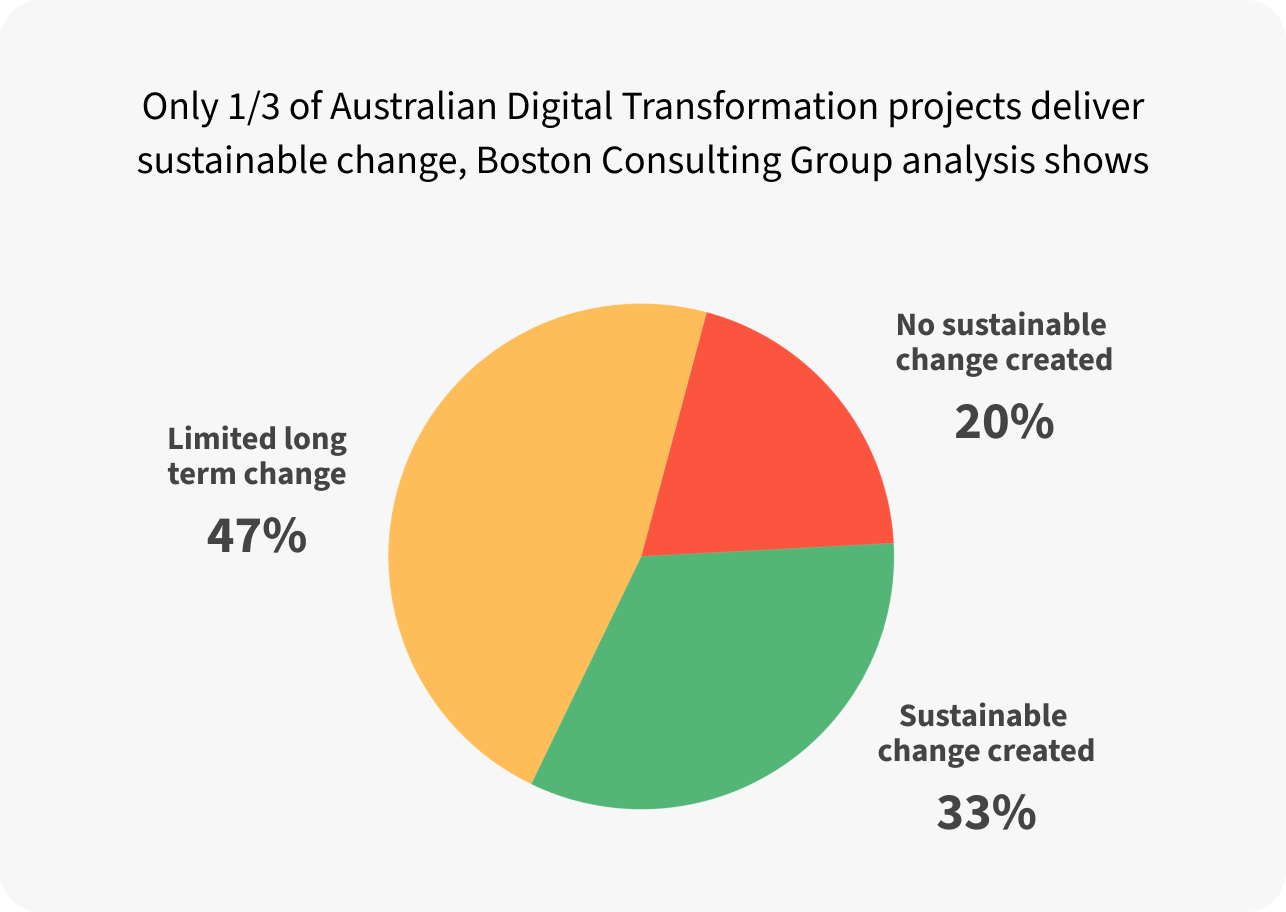 Corporate Australia’s digital transformation track record (BCG Analysis, 2021)
Corporate Australia’s digital transformation track record (BCG Analysis, 2021)Products over Projects
At Inlight, one of our guiding philosophies is simple but powerful: Treat digital assets as evolving products, not one-off projects.
This shift is more than semantic; it's a fundamental change in how we approach digital strategy. By embracing a product-oriented mindset, we foster continuous improvement, streamlined budgeting, effective teaming, and proactive maintenance.
The traditional project-based approach treats digital assets as isolated initiatives with a defined beginning and end. Once completed, they're handed off, and the team moves on. However, this approach is limiting in an age where the digital landscape is ever-evolving. Enter the product mindset, where assets are nurtured, refined, and evolved over time. This mindset recognises that even after launch, there's always room for new features and enhancements based on user feedback, technological innovations, and market shifts.
Why products?
- —Longevity and Continuous ImprovementUnlike projects that have a finish line, products are designed for the long haul. Continuous monitoring, A/B testing, and iterative improvements ensure the product stays relevant and efficient.
- —Adaptive BudgetingA product approach embraces a fluid budgeting method. Instead of a lump-sum allocation, resources are adjusted based on evolving needs, ensuring money is invested in features and adjustments that offer the most value.
- —End-to-end OwnershipWith products, teams take ownership of the entire lifecycle. There's a deeper investment in the product's success, leading to more holistic thinking and integrated solutions.
- —Return on InvestmentDefining expectations, then actively quantifying and monitoring the ongoing value an experience provides encourages a pragmatic and agile team mindset, encouraging constant optimisation and providing a clear framework for investment.
In essence, moving from a project to a product mindset is not just a shift in operational strategy; it's a cultural change. It demands a departure from rigid, short-term goals to embrace a vision of continuous growth and evolution, all underpinned by the robust framework of composability.
MVP Over End State Vision
The last idea that we strongly advocate to our clients and partners is to avoid the temptation to aim for the end-state vision in your first release to customers and instead target a minimum viable product (MVP). An MVP isn't about launching an incomplete or inferior product but rather smartly launching a product that meets core needs, enabling rapid market entry and real-time learning.
There is often a considerable excitement generated by visualising a final product that your customers would love, alongside a natural hesitancy to release anything less than perfect into the world. However, customers are usually more understanding than given credit for and have a greater appreciation for seeing continuous improvement and feedback being taken on board than experiencing a product that is exceptional on the first release but never improves.
Breaking your product or service down into its fundamental components and releasing the minimum viable version allows you:
 Release to market faster and test your hypothesis
Release to market faster and test your hypothesis Reduce investment before validating the product with real users
Reduce investment before validating the product with real users Use customer feedback to prioritise and influence new features and enhancements
Use customer feedback to prioritise and influence new features and enhancements Leave room for innovation and customer ideas in your product roadmap
Leave room for innovation and customer ideas in your product roadmap Build trust in a commitment to value through demonstrated product progression and evolution
Build trust in a commitment to value through demonstrated product progression and evolution
Whilst this strategy itself aligns with a composable philosophy, it is made significantly easier through the implementation of a composable architecture. Rather than committing to an end-to-end monolith solution that has tightly integrated functions, a composable architecture allows you to build and launch an MVP that is easily extensible and scalable over time. These two principles go hand-in-hand.
Planning and designing an MVP and subsequent evolution roadmap requires a sound understanding of your customer's needs and a way to prioritise value and impact against the effort.
At Inlight, we utilise ProductBoard to capture internal and external requirements, map these requirements to audience needs, drivers and objectives, and prioritise a release cycle to maximise value. This tool also allows us to communicate a roadmap and timeline with stakeholders to validate our assumptions and gather feedback.
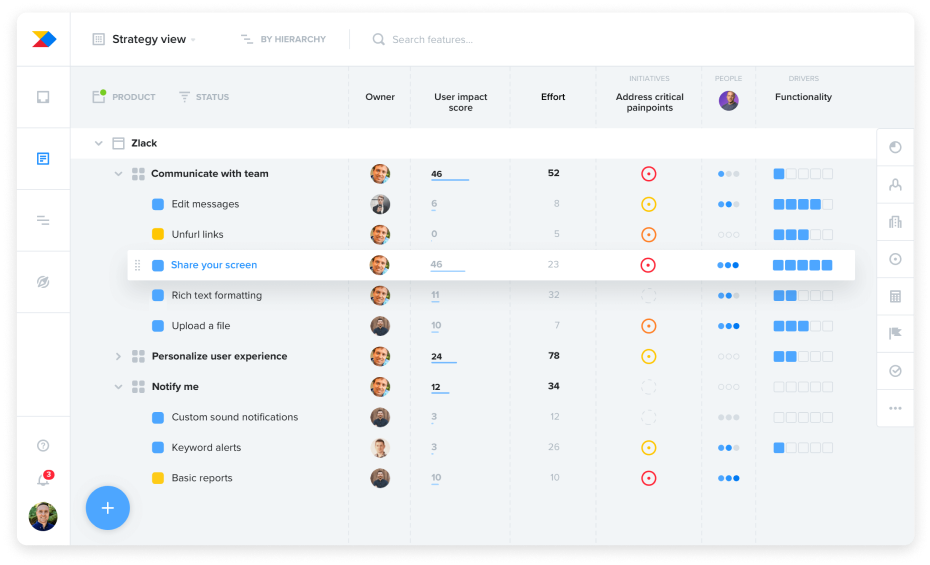 Productboard Roadmapping Tool
Productboard Roadmapping ToolOnce an MVP is out in the wild, our process doesn't stagnate. We shift gears into an agile delivery model, perpetually refining and enhancing, all the while maintaining the rhythm of a continuous delivery cycle. This agile and adaptive methodology is seamlessly supported by the composable architecture we advocate for, ensuring fluidity in our approach and longevity in our products.
Composability in your Organisation and Teams


In the digital age, staying ahead isn't just about technological dexterity; it also demands organisational nimbleness.
This adaptability is encapsulated in the concept of "composable business." As highlighted in the Gartner keynote The Future of Business is Composable", composable business is capturing attention well beyond IT departments; it's resonating across the C-suite and boardrooms.
At its essence, composable business encourages organisations to shift from static, fixed structures to dynamic, modular ones. Drawing a parallel to our earlier discussion on technology, just as monolithic software systems are broken down into discrete, flexible components, composable business urges a reimagining of the entire organisation as a collection of interchangeable blocks. These units can be quickly repositioned in response to both internal and external pressures, ensuring adaptability in real time.
It's essential to recognise that composable business represents a foundational shift in business perspective. This architectural change ensures organisations are designed for resilience, not just efficiency. As Gartner emphasises, enterprises are moving towards continuous adaptability, with a significant number of corporate directors accelerating digital strategies in response to ongoing disruptions.
At Inlight, we see the significant potential of this mindset. Our team acts as an agile pillar amidst larger, often slower-moving entities. We offer the agility to adapt, innovate, and deliver, assisting larger organisations to navigate unpredictable landscapes.
In this evolving digital world, challenges are a given. However, with a composable mindset, they become opportunities for growth and innovation. As we forge ahead, we're inspired by the vision of a future where flexibility and continuous innovation are the norms.
Part 3
Where to now


As we navigate the complexities of the digital era, the need for foresight and strategic planning becomes more pronounced. It's not merely about reacting to present challenges but preparing for the ones that lie ahead.
Ensuring the sustainability of our digital endeavours demands that we not only identify the signs indicating change but also chart a course that guides us towards progressive innovation. Let's delve into the crucial considerations for embracing a composable future.
How should you move forward?
Recognising the need for change is the first step in any digital evolution. Are you often delayed by rigid legacy systems that can't keep up with modern needs? Do your teams grapple with cumbersome processes that hamper agility? If technological constraints and inefficiencies are holding you back, it's time to consider a new direction. Even if you're deeply invested in legacy monoliths, you might be surprised that many are evolving to offer more modular, composable solutions. A migration rather than a complete overhaul might be a viable option.
When it comes to technologies that enable a more composable, agile approach, the options are abundant. From CMSs like DatoCMS, Contentful, and Sanity to search capabilities via Algolia and cloud solutions like AWS and Vercel, the modern tech stack offers a plethora of options. The key is to build a robust strategy that aligns with your specific needs and challenges, and that's where a partner like Inlight can help.

Switching to a composable approach should be the last transformation you'll ever need. Yes, it involves a significant shift in mindset and approach, but the good news is that you can start small. Identify your most pressing needs, and begin by modularising those elements of your business. This evolution can be broken down into stages, making it less daunting and more manageable to get started. Mapping out your requirements will help you draft a plan you can execute step-by-step.
How can Inlight help?
Navigating the intricacies of composable systems can be challenging, especially if you lack the expertise in-house. This is where Inlight shines, offering unparalleled guidance and adding substantial value. Our experience and proven track record in implementing composable architectures and building composable products means we're well-positioned to guide your journey, whether it involves a complete shift towards composability or modular enhancements to your existing systems.
Moreover, if you or your team would benefit from a deeper understanding of composability and its implications, Inlight offers tailored learning sessions to help build understanding. Through these sessions, we can share insights, strategies, and practical knowledge, providing a foundation for you to harness the power of composability in your business.
In our rapidly evolving digital landscape, being able to adapt and pivot is paramount. Embracing composable approaches can be your key to enduring flexibility, resilience, and responsiveness.
Ready to explore how composability can impact your organisation's future?
Contact us for a conversation or to schedule a learning session tailored to your needs.
- inlight.com.au
- hello@inlight.com.au
- +61 3 9416 4665
Related resources
- —Case Study: Nando'sHow Nando's embraced a composable strategy to build a powerful digital ecosystem.
- —Case Study: Transport Accident Commission (TAC)How TAC adopted a composable architecture to break free of core systems and deliver a winning experience.
- —Blog Post: Embracing Digital EvolutionWhy embracing evolution and thinking like a start-up can be a strategic advantage for your business.
- —Blog Post: Headless CMS: A Modern Approach to Content ManagementHow a headless CMS provides greater flexibility and performance.


